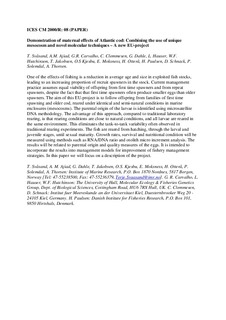Demonstration of maternal effects of Atlantic cod: Combining the use of unique mesocosm and novel molecular techniques – A new EU-project
Svåsand, Terje; Ajiad, Adnan Mosa; Dahle, Geir; Jakobsen, Tore; Kjesbu, Olav Sigurd; Moksness, Erlend; Otterå, Håkon; Solemdal, Per; Thorsen, Anders
Working paper

Åpne
Permanent lenke
http://hdl.handle.net/11250/100635Utgivelsesdato
2000Metadata
Vis full innførselSamlinger
Originalversjon
This report is not to be quoted without prior consultation with the General Secretary.Sammendrag
One of the effects of fishing is a reduction in average age and size in exploited fish stocks,
leading to an increasing proportion of recruit spawners in the stock. Current management
practice assumes equal viability of offspring from first time spawners and from repeat
spawners, despite the fact that that first time spawners often produce smaller eggs than older
spawners. The aim of this EU-project is to follow offspring from families of first time
spawning and older cod, reared under identical and semi-natural conditions in marine
enclosures (mesocosms). The parental origin of the larvae is identified using microsatellite
DNA methodology. The advantage of this approach, compared to traditional laboratory
rearing, is that rearing conditions are close to natural conditions, and all larvae are reared in
the same environment. This eliminates the tank-to-tank variability often observed in
traditional rearing experiments. The fish are reared from hatching, through the larval and
juvenile stages, until sexual maturity. Growth rates, survival and nutritional condition will be
measured using methods such as RNA/DNA ratio and otolith micro increment analysis. The
results will be related to parental origin and quality measures of the eggs. It is intended to
incorporate the results into management models for improvement of fishery management
strategies. In this paper we will focus on a description of the project.
Utgiver
ICESSerie
ICES CM documents2000/R:08